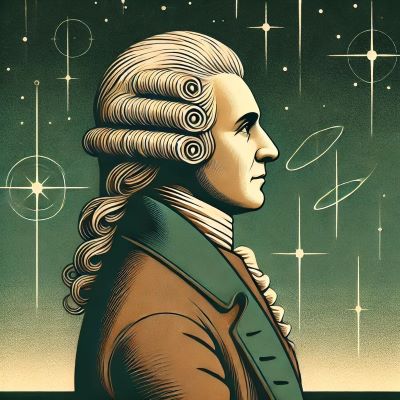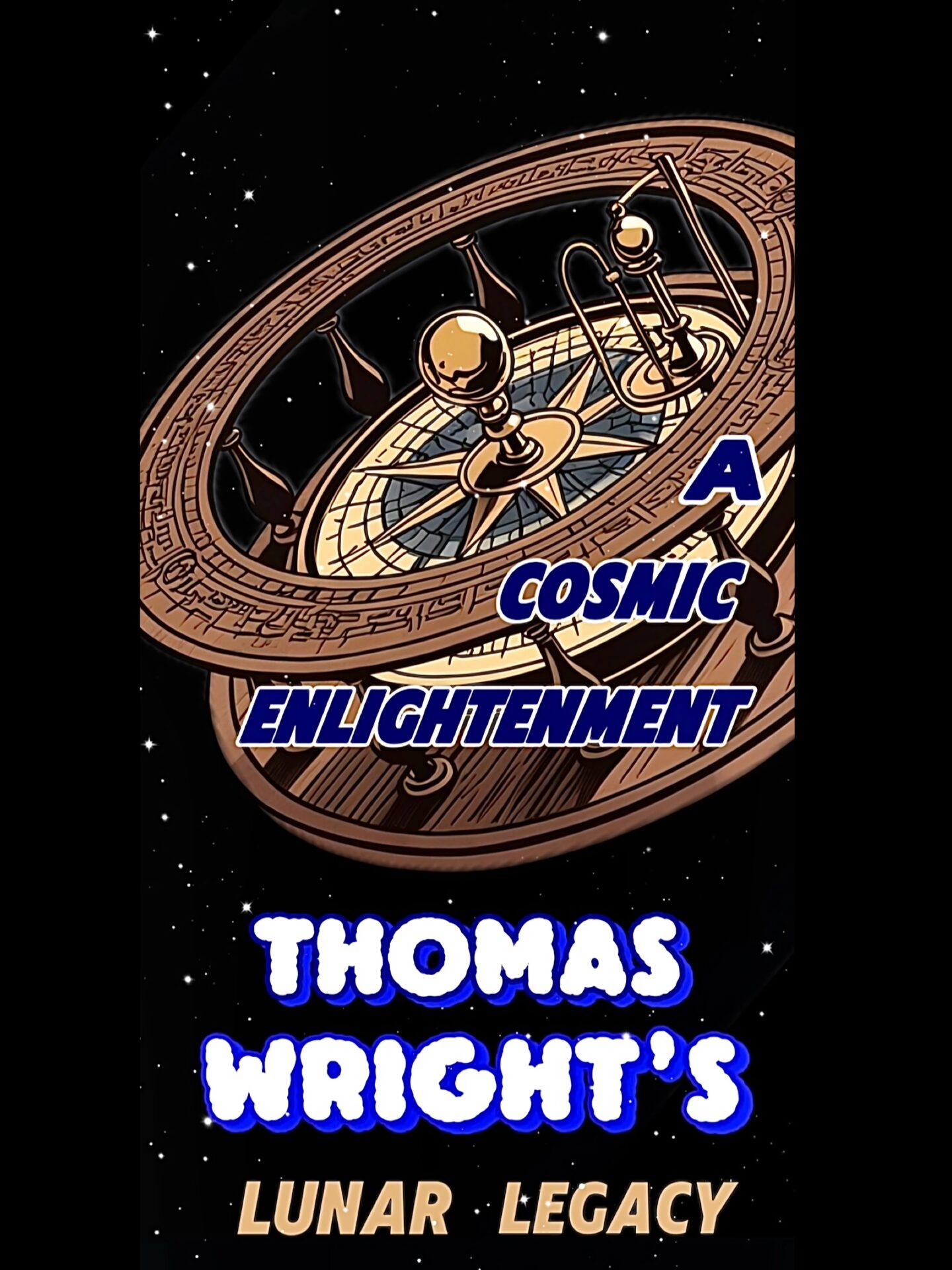What was the Enlightenment, and who was Thomas Wright?
The Enlightenment was an intellectual movement that sought to better understand our world through curiosity and knowledge. Enlightenment thinkers would combine existing ideas around philosophy, science and religion, breaking down these traditional barriers!
This made way for new ideas, voices and even technological advancements. By opening their minds to new ways of thinking, scientists and instrument makers, like Thomas Wright, were able to learn so much more about our galaxy.
Astronomer Thomas Wright is perhaps less heard of than the likes of Isaac Newton, however it is important to appreciate his pioneering contributions to science. As the first to describe the motions of our Milky Way, and seeing the potential for galaxies beyond our own, Wright’s intellectual legacy led the way for later Astronomers to understand the universe as far bigger than previously thought.
启蒙运动是什么?托马斯·赖特是谁?
启蒙运动是一场旨在通过好奇心和知识更好地理解我们世界的思想运动。启蒙思想家结合了关于哲学、科学和宗教的现有观点,打破了这些传统的界限!这种探索为新的思想、声音甚至技术进步铺平了道路。通过接受新的思维方式,科学家和仪器制造者(如托马斯·赖特)得以对我们的银河系有了更多的了解。
如今,我们留下了许多精美的探索工具,例如望远镜、测量仪、天体仪和显微镜,这些工具帮助伟大的思想家追寻知识的奥秘。这些物件有时也被用于教育,向公众展示宇宙的奇妙。
与艾萨克·牛顿等知名人物相比,天文学家托马斯·赖特的名字或许鲜有人知,但我们应当重视他在科学领域的开创性贡献。赖特是第一个描述银河系运动的人,并预见了我们银河系以外星系的可能性。他的思想遗产为后来的天文学家理解宇宙的无限广阔奠定了基础。
Portrait of Thomas Wright
1711-1786
English Astronomer and Instrument Maker
Artwork by Riya Jayakumar, 2024.

Video produced by Xinming Chen, 2024


Orrery by Thomas Wright
1735-1745, wood, metal, paint.
click here
This orrery, crafted by Thomas Wright in London, embodies Enlightenment ideals of accessible knowledge for “Ladies and Gentlemen.” It features the Sun, Earth, Moon, Mercury, and Venus. The Earth rotates on its axis and orbits the Sun via a winding mechanism. The unique outer ring, marked with zodiac signs, compass points, and calendars, allows users to predict celestial events. This shows the expanding reach of scientific exploration. It invites everyone to discover the wonders of the universe. To see how these findings shape our view of the world.
中文
这个由托马斯·赖特在伦敦制作的展品,体现了启蒙运动的思想,即公众们也可以被允许学习科学知识。它描绘了太阳、地球、月球、水星和金星。地球绕着自己的轴线旋转,并通过一个旋转装置绕太阳公转。独特的外圈,标有十二生肖,指南针点和日历,允许用户预测天体事件。这体现了科学探究的范围扩展,邀请每个人探索宇宙的奇迹,看看这些发现如何塑造我们对世界的理解。

Drawing of Grand Orrery by Thomas Wright and engraving of ‘The Grand Orrery’ by John Rowley
1715-1728
click here
This drawing by Thomas Wright (1711–1786) shows a grand orrery, a model of the solar system. It illustrates the movements of celestial bodies in precise orbits around a central sun. The design reflects Enlightenment ideals of science and reason. Wright highlights the order and motion of the cosmos. The orrery symbolizes humanity’s effort to understand the universe through observation and mathematics, combining scientific precision with artistic beauty.
中文
这幅由托马斯·赖特(1711–1786)创作的图画展示了一台大型的天体仪,这是一种模拟太阳系的模型。它精确地描绘了天体围绕中心太阳运行的轨迹。其设计体现了启蒙时代关于科学与理性的理念。赖特突出了宇宙的秩序与运动。这台天体仪象征着人类通过观察和数学来理解宇宙的努力,融合了科学的精确性与艺术的美感。

George II’s Grand Orrery
1733
click here
This grand orrery, created during the reign of George II (1727–1760), represents the scientific ingenuity and artistry of the 18th century. It models the solar system, showing the motions of planets and moons around the sun through intricate clockwork mechanisms. With detailed planetary spheres and concentric gears, it visualizes celestial mechanics and the heliocentric universe.
Orreries like this bridged science and art, expanding our understanding of the cosmos and embodying Enlightenment values.
中文
这台大型天体仪制作于乔治二世时期(1727–1760),展现了18世纪的科学创造力与艺术工艺。它模拟了太阳系,通过复杂的钟表机械演示行星和卫星围绕太阳的运动。天体仪上精细的行星球体和同心齿轮生动地展现了天体力学和日心宇宙的概念。
像这样的天体仪连接了科学与艺术,拓展了我们对宇宙的理解,并体现了启蒙时代的价值观。

Gregorian reflecting telescope of 2 5/8 inch aperture and 16 inch focal length by Thomas Wright
1826-1842
click here
The Gregorian telescope was able to capture an image using a curved mirror in addition it’s primary mirror, reflecting the observed image back through the lens. This telescope belonged to Thomas Wright!
Typically used for space observation, the Gregorian telescope produced a much clearer image through its combination of primary and secondary mirrors. The curved, second mirror would provide an upright image, whilst reducing light loss, making it perfect for observations of space.
Observation was very important to the Enlightenment thinkers and scientists, so more advanced instruments like the Gregorian telescope were essential. Wright’s telescope comes with a stand and tripod attached, for easy, comfortable use.
中文
格里高利望远镜通过使用一个弯曲的次镜和主镜,能够捕捉影像,并将观测到的影像反射回镜头。这台望远镜属于托马斯·赖特!
格里高利望远镜通常用于空间观测,通过主镜和次镜的组合,它能够生成更加清晰的影像。弯曲的次镜可以提供正立影像,同时减少光线的损失,非常适合用于太空观测。
观测对于启蒙思想家和科学家来说至关重要,因此像格里高利望远镜这样更先进的仪器必不可少。赖特的这台望远镜配有底座和三脚架,便于用户舒适地进行使用。

English Horary Quadrant
1718-1747
click here
This horary quadrant was more than just a tool for measuring time; it was a gateway to the universe. Created during the Enlightenment era, it symbolizes the intersection of science, philosophy, and art. Through this instrument, astronomer Thomas Wright envisioned bringing astronomy to the public and reshaping how society views the cosmos. By challenging the exclusivity of knowledge, he inspired new ways of seeing the universe. What does it mean to see the universe through a new lens?
中文
这件时辰象限仪不仅仅是一个测量时间的工具;它更是通向宇宙的入口。它诞生于科学、哲学与艺术交汇的启蒙时代。天文学家托马斯·赖特希望通过这件仪器将天文学带向大众,并重塑社会对宇宙的认知。他挑战了知识的专属性,启发人们用全新的视角看待宇宙。通过新的视角看待宇宙,究竟意味着什么?

Microscope
c.1738
click here
This microscope, made by Thomas Wright around 1738, exemplifies the intersection of art and science in the Enlightenment era. Its red shagreen-covered body and triangular supports reflect Wright’s attention to both function and aesthetics. Equipped with multiple lenses and tools, this instrument revealed the invisible details of nature, offering new ways to explore the world. At a time when scientific ideas began to extend beyond the ruling elite, instruments like this helped bring the wonders of nature closer to the public.
中文
这台显微镜由托马斯·赖特于1738年左右制作,是启蒙时代科学与艺术交融的典范。其红色鲨鱼皮镜身和三角形支架展现了赖特对功能与美学的双重追求。赖特为这台显微镜配备了多种镜片和工具,揭示了自然界肉眼无法看到的细节,让人们以全新的方式探索世界。在科学理念开始超越精英阶层传播的时代,这样的仪器让自然的奇观更贴近公众。

Orrery Planetary Model by Thomas Wright
1718-1747
click here
The Earth-Moon Globe, or “Orrery,” made by Thomas Wright in the mid-18th century, uses gears to show the movements of the Sun, Earth, and Moon. It reflects the Enlightenment’s goal of making science accessible. Used in public talks to illustrate Newton’s ideas, it helped people visualize the universe. Today, this approach continues to inspire science communication, making complex ideas like the origins of the cosmos easier to grasp. The goal remains the same: make science engaging and accessible.
中文
18世纪中期由托马斯·赖特(Thomas Wright)制作的地球-月球地球仪(Earth-Moon Globe),用齿轮来显示太阳、地球和月球的运动。它反映了启蒙运动的目标,即让科学变得通俗易懂。在公开演讲中用来说明牛顿的思想,它帮助人们想象宇宙。今天,这种方法继续激励着科学交流,使像宇宙起源这样复杂的想法更容易理解。我们的目标仍然是一样的:使科学具有吸引力和可获得性。

COPYRIGHT
All images have been taken from the Science Museum Group online collection, all released under a CC BY-NC-SA 4.0 Licence (Creative Commons License).
For more information, visit:
https://collection.sciencemuseumgroup.org.uk/about
Science Museum Group: Object References
Orrery by Thomas Wright: https://collection.sciencemuseumgroup.org.uk/objects/co1517/orrery-by-thomas-wright.
Drawing of Grand Orrery by Thomas Wright and engraving of ‘The Grand Orrery’ by John Rowley:
George II’s Grand Orrery:
https://collection.sciencemuseumgroup.org.uk/objects/co1522/george-iis-grand-orrery.
Gregorian reflecting telescope of 2 5/8 inch aperture and 16 inch focal length by Thomas Wright:
English horary quadrant, 1718-1747:
https://collection.sciencemuseumgroup.org.uk/objects/co56628/english-horary-quadrant-1718-1747.
Microscope (c.1738):
https://collection.sciencemuseumgroup.org.uk/objects/co8690/microscope-c-1738
Orrery planetary model by Thomas Wright, 1718-1747:
